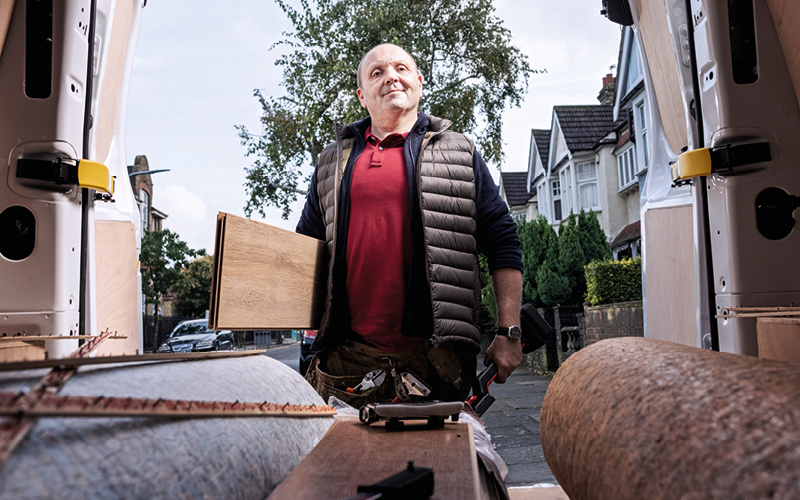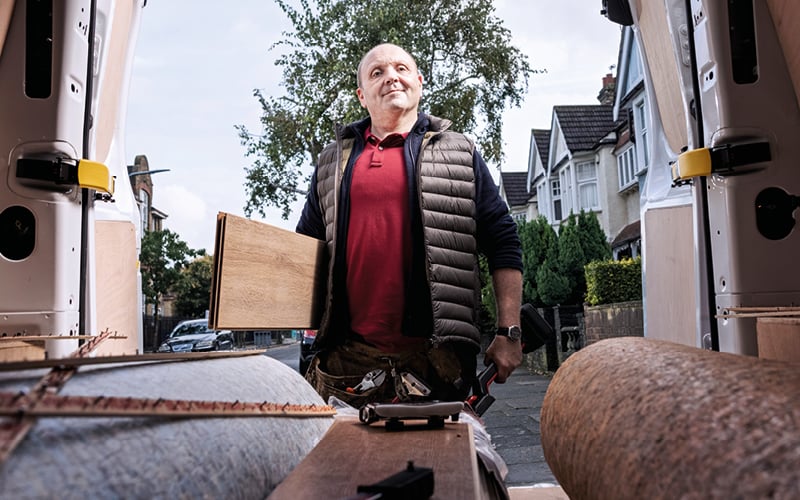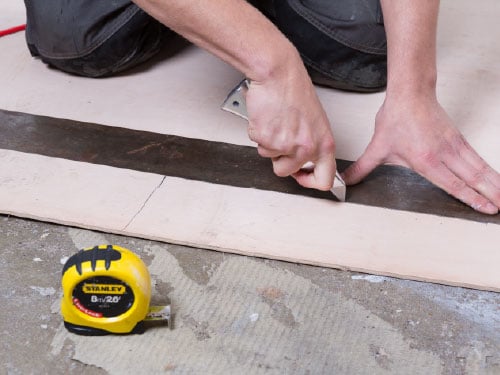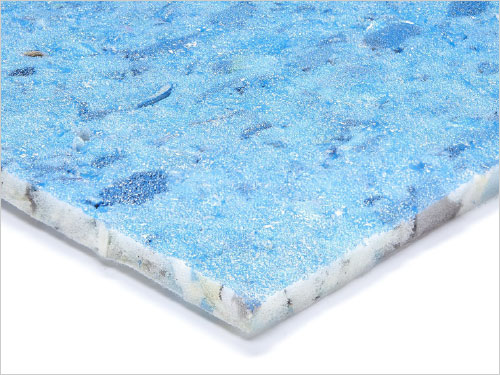How to fit a carpet
Once you’ve chosen the flooring that’ll transform your home, it’s time to get it fitted! We’d always recommend using a professional flooring fitter for the best possible finish.
But if you’re feeling up to the challenge and want to do it yourself, we’re here to help. Our fitting guide contains our expertise to help make fitting easier. Read on to find out how to measure your new carpet, what tools and accessories you'll need, how to lay a carpet, and how to care for a new carpet.
Carpetright arranged fitting service

If you're still unsure whether you want to fit your carpet yourself or hire a professional carpet fitter, then you can talk to our team. At Carpetright, we have plenty of experts on hand to make every step of the process as smooth as possible. Through the carpet fitting service offered, we can arrange for an approved fitting service for you.
- Select fitting when you checkout online or chat to a team member in-store to arrange your fitting.
- As well as arranging the standard fitting service, we can also arrange for the fitter to uplift and dispose of your existing floor covering. For a small fee, the fitter will take up and dispose of your old flooring before they fit your new one. That’s one less thing to worry about!
Get all the details on our professional fitting arrangement service.
The steps to carpet fitting
Whether you decide to use our fitting arrangement service or get right to it and do it yourself, you will find everything you need to know in this fitting guide.
We'll cover every step of the installation process including:
How to measure for carpet
It doesn’t have to be perfect but the measurements need to be accurate. Just a simple drawing with all the rooms shown is all you need. If you would like some help with how to do home measurements, you can book a virtual consultation with one of our advisors.
Remember to add 5% extra for waste. This ensures that you have enough carpet when accounting for indentations and scraps.
How to measure stair carpet
Measuring carpet for stairs may seem fiddly, but when it comes to stairs or steps, the process is similar.
Measure the height and depth of each stair to give you the length before multiplying by the width. This will give you the area of each step.
Again, don’t forget to allow 10% for waste and to allow for any margin of error as staircases can be tricky.
Watch our step-by-step video guides to measuring different room shapes from a simple room to a room with a join or extra space.
How to measure a simple room accurately
Watch our step-by-step guide to accurately measuring a simple room. This shows you what equipment you need and how to calculate the correct area. It's never been easier to get a perfect fit.
How to measure a room with extra areas
Learn the basic steps to accurately measure a room with extra areas and understand how much carpet you'll need by watching our helpful video.
How to measure a room which needs a join
If your room is wider than the 4m or 5m widths that carpets come in, then you'll need to join two rolls together. Learn how to accurately measure a room that requires a join with our step-by-step guide.
If you’d rather leave it to an expert, just pop your name in our simple online form and arrange an appointment for our free measuring service. We’re guaranteed to be fast and accurate. Less waste means less overall cost!
Carpet fitting tools
Before you get started, make sure you have the right kit! It's best to be prepared for whatever you might come across once you start lifting your old carpet and ensure that you can finish the job. Many of the tools you may already have in your toolbox and most DIY outlets will sell everything else. Tools you might need include:
• Knee pads
• Tape measure
• Pencil
• Masking tape
• Hammer or nail gun
• 19mm & 10mm nails
• 3mm hardboard sheets
• Pipe and cable detector
• Gloves
• Hack saw
• Carpet tape
• Craft or Stanley knife
• Carpet stretcher
• Carpet tucker
• Drill
• Vacuum cleaner
Removing old carpet and preparing your floor for new carpet
The first step to fitting your new carpet is removing your old carpet and preparing your sub-floor. The sub-floor is just the foundation underneath the floor, usually, this is concrete or wood. If the sub-floor isn’t prepared properly, it will affect the way that your carpet lies and potentially ruin the overall finish.
Removing your old floor
Before fitting your new carpet you probably have some old flooring to remove, as well as preparing the sub-floor underneath. At Carpetright we make fitting a new floor easy at every step. In addition to our approved fitting arrangement service, we can also arrange to uplift your old flooring and dispose of it for you to ensure that you experience a hassle-free fit.
How to prepare your sub-floor for carpet
• Always wear knee pads when working on flooring.
• If a lot of your floorboards are damaged, it’s cheaper and easier to pull them all up and start again. Use fit tongue-and-groove chipboard flooring panels which will give you a great base for your final flooring.
• 3mm hardboard sheets are best to level your boarded floor, plus they’ll help to reduce any draughts coming from below. Always make sure the boards have been conditioned beforehand by spraying them with water over the textured side and then stacking them in the room in which they are going to be used back to back. Leave them for at least 48 hours and as they dry they’ll retract back. This reduces the risk of the boards expanding after they’ve been fitted.
• Prepare your boards by ensuring no nails are sticking out above the surface and nailing down any loose boards.
• Make sure you use 19mm nails to lessen the risk of piercing through the floorboard into pipes or cables.
• Space the nails about 150mm apart around the edges, but 225mm apart in the centre. It’s a good idea to start in the centre of one edge and work across the board to the other side.
• Lay the hardboard sheets texture-side up as you’ll need something for any adhesive to stick to. Start in a corner of the room and set the nails about 13mm in from the edges of the sheet in a pyramid pattern. It’s a good idea to use something as a spacer like a piece of wood.
• Push the sheets together and nail the edges where the sheets meet first. When you finish the first row of boards the last one will need to be cut to size.
• Use this off-cut from the last sheet in the first row to start the second row and carry on in the same way. This reduces waste and also helps by ensuring the joints are staggered.
Learn more about our uplift and disposal service.
Fitting carpet grippers and underlay
Carpet grippers
Available in lengths of 1m, a carpet gripper is a rod that comes with angled nails to provide a firm grip on your floors. These gripper rods are thick and rigid to provide an ultra-strong grip and keep the carpet taut, preventing any lumps and bumps. Simple to use, carpet gripper can be cut to size and can be used on concrete or wooden floors.
Do I need to use carpet grippers?
Yes, if you want a good finish to your carpet then using carpet grippers will help it look smooth and professional. This is will increase the longevity of your carpet and keep it looking and feeling new for longer. Get your carpet grippers alongside your new carpet from us.
Before you start it is important to locate any hidden wires or pipes using a pipe and wire detector. If you find a pipe or wire, mark the spot in these areas and use gripper adhesive instead of nails. Make sure you wear gloves when handling the gripper as the pins are very sharp. Grippers should be fitted all around the edge of your room except across door thresholds. Measure between the door frame and then cut the trim with a hack saw.
- For wooden floors use 10mm nails or screws.
- Place the gripper rods 2/3 of the carpet thickness away from the skirting boards with the pins pointing towards the skirting boards.
- Use a hacksaw to cut the gripper to size. Carpet gripper comes with nails or screws already in situ so hammer in the nails or screw in the screws.
- If the floor is concreted, use Gripfill and leave to dry.
- Follow the above instructions but use a bead of Gripfill under the gripper rods. This will help to maintain the integrity of the grippers if the nails work loose over time.
Carpet underlay
It’s worth investing in a good underlay. Not only does it affect how your flooring looks and feels, it can also increase its longevity. It can also help to significantly reduce your energy bills by trapping heat and increasing insulation.
How to fit carpet underlay
- Lay the underlay loosely in the space, ensuring the rubber side is facing down.
- Using a craft or Stanley knife cut it so that the underlay is at the same level as the grippers.
- Butt the edges together and join them with tape, ensuring that the edges do not overlap and that the underlay is flat and level.
Underlay is an essential part of fitting a carpet correctly. It comes in many types, so if you’re not sure which one is right for your carpet, our underlay buying guide will give you all the information on the different materials, the advantages of each and what their ratings mean.
How to lay a carpet
In this section we show you how to lay a carpet and how to make sure you get the best overall finish.
Top Tip
Use a carpet stretcher (sometimes called a knee kicker) to stretch carpet onto the gripper. This tool has a flat plate with teeth at one end and a padded cushion at the other. The teeth grip the carpet while whoever fits the carpet pushes the padded end with their knee.
Follow our helpful step-by-steps to fit your carpet perfectly:
1: Lay your carpet loosely in position. Stand in one corner with a foot underneath the carpet. Use the other foot to smooth the carpet into place, leaving around 50-75mm excess on every edge. If necessary, cut the carpet to size.
2: Cut this excess vertically above the corners and trim the overlapping triangles.
3: Starting from the longest wall and working your way backwards, begin fitting the carpet. Use a carpet tucker to make a firm crease in the carpet along the skirting board. This will give you a fold line.
4: Using a sharp knife, cut along the edge, around 5mm higher than the carpet surface. Hold the carpet flat to the floor while you cut.
5: Take the carpet stretcher and place it around 25mm from the skirting, teeth facing down. Push the padded end firmly with your knee so the carpet hooks onto the gripper on either side of the corner.
6: Using the carpet tucker, push the excess carpet down between the skirting and the gripper. Repeat this process until the first wall is complete, then work along the two adjacent walls and finally the opposite one.
7: To fit carpet around tricky shapes such as door frames, cut down the edge vertically in several places, then trim it so it’s flush. For a pipe, cut straight from the carpet edge to the centre of the pipe then press the carpet around it. Trim it by running the knife round the base at a 45 degrees angle until the carpet lies flat.
8: For fitting carpet across a doorway, cut it so it is in line with the next room’s flooring. You will then need to then fit a door bar (see below) making sure the carpet edge is firmly in place underneath it.
Fitting a door bar
Door bars are the metal or wooden strips that you typically find in doorways. These neatly join different flooring types across door thresholds and help secure seams as well as make your carpets look neat. Read our top tips for how to fit your door bar correctly:
Unsure of what door bar you need? Read our guide to buying flooring accessories for more information on choosing the right threshold bar for the perfect finish.
1: Make sure you have the right door bar depending on your flooring types and heights.
2: The correct position for a door bar is centrally across the threshold so it cannot be seen on either side when the door is closed. Once you have positioned your door bar centrally like this, cut the bar to the right length with a hack saw.
3: Check for pipes or cables under the floor by using a pipe and wire detector.
4: For a concrete floor, drill the holes with a power drill using a masonry bit and insert wall plugs. You can then fit your door bar.
5: For a wooden floor, make pilot holes first to ensure you have the right positioning before screwing the door bar to the floor.
Shop our range of door bars and flooring accessories for all floor types and room designs.
In the days after fitting...
Whether you fit your carpet yourself or hire a professional, you might find that your carpet sheds some fibres. This is totally normal. Regular vacuuming, daily if possible during the first few weeks, will solve this issue. A vacuum cleaner fitted with a beater bar and/or brushes is recommended for cut pile carpets and one without a beater bar or brushes is best for loop pile carpets.
Why does my new carpet smell?
Once the carpet is fitted, there may be a slight odour which may be caused by the carpet or the underlay. This is called "off-gassing" and is due to chemicals called volatile organic compounds (VOCs) used in household items such as carpet adhesive, paint, and pressed-wood furniture. They evaporate at room temperature, which is why your carpet begins to smell once it is laid in your house.
There is no danger from this gas, but many people don't like the smell. Ideally, you should ventilate the room well by opening windows and doors for 72 hours. Vacuuming the carpet can also help get rid of the odour.
Read our carpet care guide to find out more on how to best clean your carpets.










